
- •Contributors
- •Table of Contents
- •Preface
- •Technical requirements
- •Installing a Power BI gateway
- •Getting ready
- •How it works
- •Authentication to data sources
- •Getting ready
- •How it works
- •Main challenges that Power Query solves
- •Getting ready
- •Technical requirements
- •Getting data and connector navigation
- •Getting ready
- •Creating a query from files
- •Getting ready
- •How it works...
- •Creating a query from a folder
- •Getting ready
- •How it works...
- •Creating a query from a database
- •Getting ready
- •How it works...
- •Creating a query from a website
- •Getting ready
- •How it works...
- •Technical requirements
- •Exploring Power Query Editor
- •Getting ready
- •Managing columns
- •Getting ready
- •Using data profiling tools
- •Getting ready
- •Using Queries pane shortcuts
- •Getting ready
- •Using Query Settings pane shortcuts
- •Getting ready
- •Using Schema view and Diagram view
- •Getting ready
- •Technical requirements
- •Formatting data types
- •Getting ready
- •Using first rows as headers
- •Getting ready
- •Grouping data
- •Getting ready
- •Unpivoting and pivoting columns
- •Getting ready
- •Filling empty rows
- •Getting ready
- •Splitting columns
- •Getting ready
- •Extracting data
- •Getting ready
- •Parsing JSON or XML
- •Getting ready
- •Exploring artificial intelligence insights
- •Getting ready
- •Technical requirements
- •Merging queries
- •Getting ready
- •Joining methods
- •Getting ready
- •Appending queries
- •Getting ready
- •Combining multiple files
- •Getting ready
- •Using the Query Dependencies view
- •Getting ready
- •Technical requirements
- •Setting up parameters
- •Getting ready
- •Filtering with parameters
- •Getting ready
- •Folding queries
- •Getting ready
- •Leveraging incremental refresh and folding
- •Getting ready
- •Disabling query load
- •Getting ready
- •Technical requirements
- •Using M syntax and the Advanced Editor
- •Getting ready
- •Using M and DAX – differences
- •Getting ready
- •Using M on existing queries
- •Getting ready
- •Writing queries with M
- •Getting ready
- •Creating tables in M
- •Getting ready
- •Leveraging M – tips and tricks
- •Getting ready
- •Technical requirements
- •Adding columns from examples
- •Getting ready
- •Adding conditional columns
- •Getting ready
- •Adding custom columns
- •Getting ready
- •Invoking custom functions
- •Getting ready
- •Clustering values
- •Getting ready
- •Technical requirements
- •Using Power BI dataflows
- •Getting ready
- •Centralizing ETL with dataflows
- •Getting ready
- •Building dataflows with Power BI Premium capabilities
- •Getting ready
- •Understanding dataflow best practices
- •Getting ready
- •Technical requirements
- •Exploring diagnostics options
- •Getting ready
- •Managing a diagnostics session
- •Getting ready
- •Designing a report with diagnostics results
- •Getting ready
- •There's more…
- •Using Diagnose as a Power Query step
- •Getting ready
- •Other Books You May Enjoy
- •Index
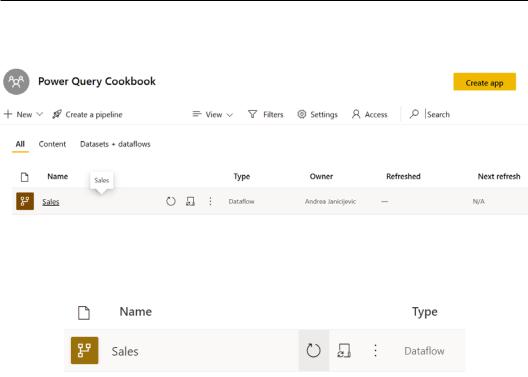
314Performance Tuning with Power BI Dataflows
14.When closing the dataflow details view, you will go back to the workspace view and you will see the newly created content:
Figure 9.15 – Dataflows inside the workspace
15.Click now on the refresh icon to effectively load the data inside the storage of your Power BI Pro account:
Figure 9.16 – Refresh icon
You have seen how easy it is to create a dataflow. You can apply Power Query transformations and define data preparation steps directly from the browser and organize the content in workspaces.
Centralizing ETL with dataflows
Data preparation and transformation at an enterprise level, meaning managed centrally, compared to a self-service approach where you can perform your own data cleaning, is one of the most expensive and difficult tasks to manage within a company. Also called centralized ETL, this task is traditionally associated with enterprise tools, but with Power BI dataflows, you can extract, transform, and load data by connecting to data sources, transforming the data applying business logic, and then modeling the data to produce reports and do further analysis.
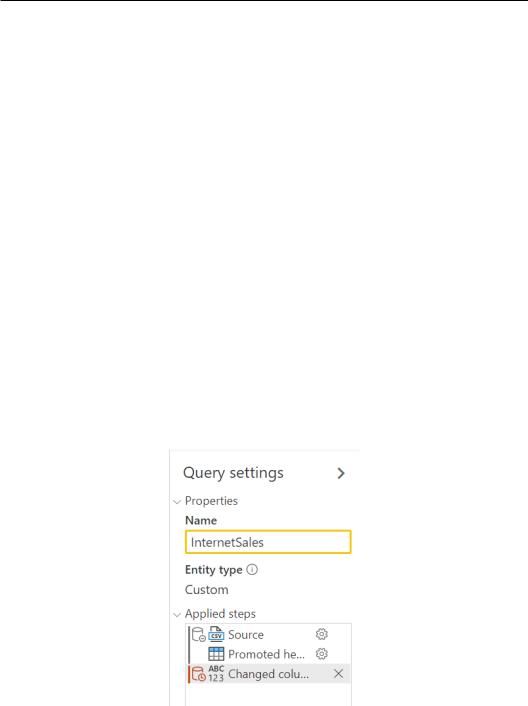
Centralizing ETL with dataflows 315
In this recipe, you will see how you can create multiple dataflows, and that these can be used by multiple users in their data models to produce reports and visualize all these pieces in the lineage view.
Getting ready
For this recipe, you need to have access to the Power BI portal, for which a Power BI Pro license is needed. You also need to have access to a Power BI workspace.
How to do it...
After you log in to the Power BI portal, perform the following steps:
1.Browse to your workspace, click on New and click on Dataflow.
2.Then click on Add new tables to connect to a data source.
3.Click on the Web API connector to connect to a CSV file from the GitHub repository.
4.Enter the following URL to connect to a CSV file loaded in the Power Query Cookbook GitHub repository: https://github.com/
PacktPublishing/Power-Query-Cookbook/blob/main/Chapter09/ FactInternetSales.csv. Click on Next to see a data preview.
5.A data preview page will appear, then click on Transform data.
6.Once the Power Query UI appears on the web page, rename the query to InternetSales under the Query settings section on the right side of the UI:
Figure 9.17 – Query settings
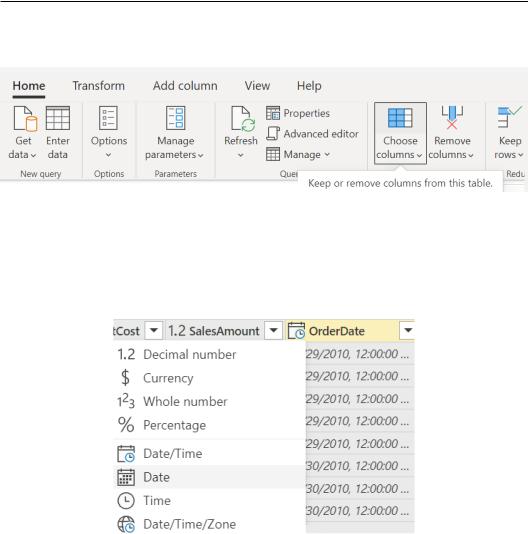
316Performance Tuning with Power BI Dataflows
7.Let's apply some common Power Query transformation tasks such as Choose columns. Browse to the Home tab and click on the Choose columns button:
Figure 9.18 – Choose columns button
8.Select the ProductKey, OrderDateKey, OrderQuantity, TotalProductCost, SalesTerritoryKey, SalesAmount, and OrderDate columns and click on OK.
9.Now change the OrderData column's data type to Date:
Figure 9.19 – Change the data type
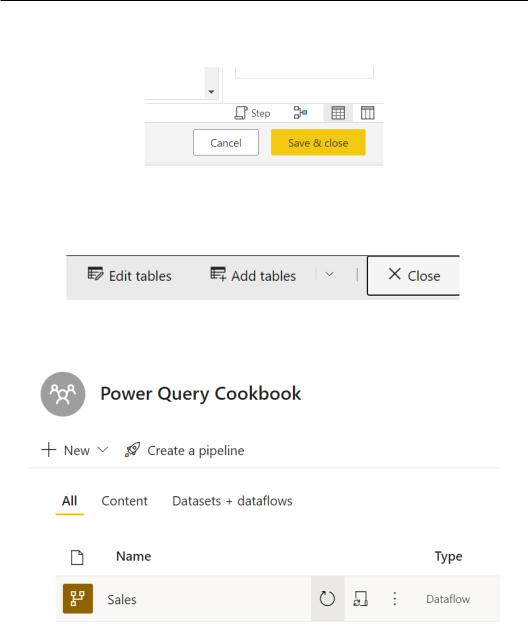
Centralizing ETL with dataflows 317
10.Now let's save this query and click on the Save & close button at the bottom right of the UI:
Figure 9.20 – Save & close button
11.Name this dataflow Sales and then click on Save.
12.Click on the Close button at the top right of the UI:
Figure 9.21 – Close dataflow view
13. Click on the refresh icon now to load the data in the underlying storage:
Figure 9.22 – Refresh icon
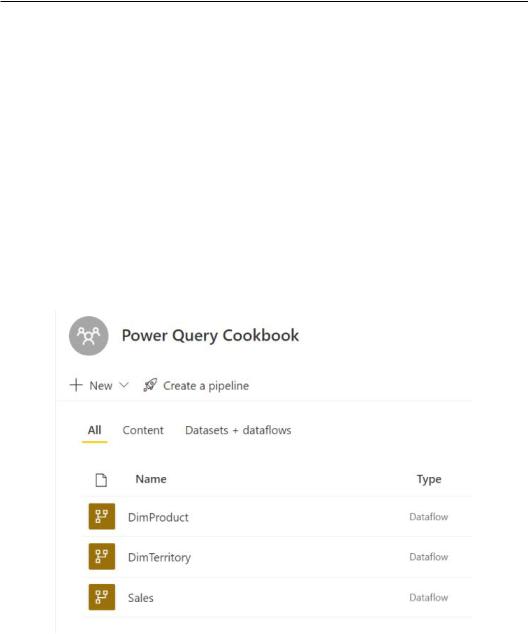
318 Performance Tuning with Power BI Dataflows
Following these steps, you have created the first dataflow. Now let's again perform steps 1 to 6 and 10 to13 for the CSV files containing DimProduct and DimTerritory. The only steps not to perform are the data transformation ones from 7 to 9.
When loading DimProduct and DimTerritory, refer to the following GitHub links when connecting through the Web API connector:
•https://github.com/PacktPublishing/Power-Query-Cookbook/ blob/main/Chapter09/DimProduct.csv
•https://github.com/PacktPublishing/Power-Query-Cookbook/ blob/main/Chapter09/DimTerritory.csv
When repeating step 6, rename the queries to DimProduct and DimTerritory, and at step 11, name the dataflows in the same way.
Once you have created these three dataflows, you will see them displayed within the workspace as in the following screenshot:
Figure 9.23 – Dataflows inside the workspace

Centralizing ETL with dataflows 319
Let's now see how we can use these three dataflows in Power BI. Once you open the Power BI Desktop application, perform the following steps:
1. Click on Get data and select the Power BI dataflows connector:
Figure 9.24 – The Power BI dataflows connector
2.Authenticate with your user account and click on Connect. In this way, you will be able to access workspaces you have permission to and connect to dataflows:
Figure 9.25 – Power BI dataflows authentication

320Performance Tuning with Power BI Dataflows
3.The Navigator window will pop up, where you can see what dataflows you can connect to. Select the workspace where you have created the three dataflows Sales,
DimProduct, and DimTerritory. In this case, select Power Query Cookbook and then expand the three dataflows' names and flag DimProduct, DimTerritory, and InternetSales. On the right side, you can see a preview of the data, as in the following screenshot:
Figure 9.26 – Dataflow navigator
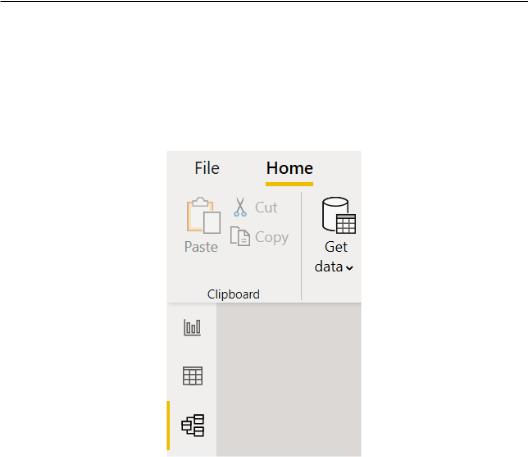
Centralizing ETL with dataflows 321
You can load and transform data as you normally do with any other data source. You can apply additional Power Query transformations from Power BI Desktop and then load data into your model. In this case, we will directly load the queries in the model.
4.After you have clicked Load, go to the Model view by clicking on the third icon tab on the left side of the UI:
Figure 9.27 – Model view icon
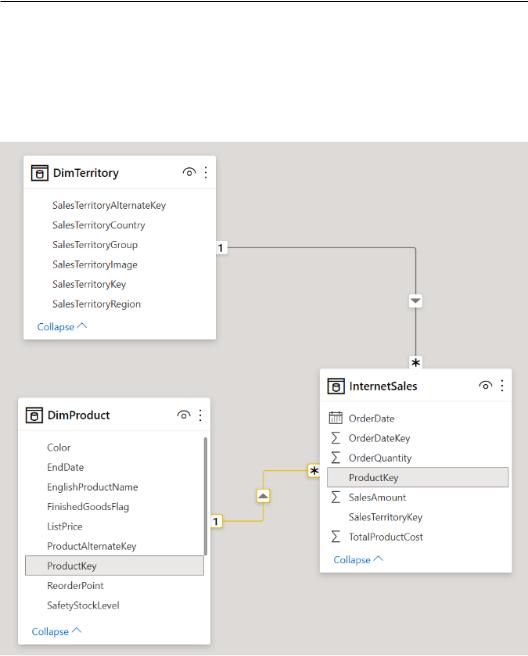
322 Performance Tuning with Power BI Dataflows
Check the relationships between the DimProduct and DimTerritory tables and InternetSales. You should see the relationships that have already been detected as shown in Figure 9.28 If not, hover your cursor on top of the ProductKey column in DimProduct and drag it to the same column in InternetSales and create a relationship. Repeat the same with DimTerritory to obtain something like in the following screenshot:
Figure 9.28 – Model view

Centralizing ETL with dataflows 323
5.Now go back to the Report view and create a visual as you like (in this recipe, we are focusing on the end-to-end flow; we will not focus on developing a report). In this case, we will quickly create a table like the following one:
Figure 9.29 – Visual creation
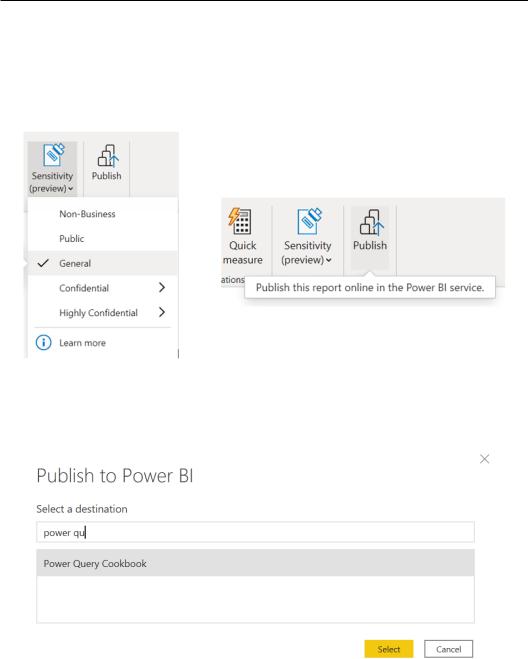
324Performance Tuning with Power BI Dataflows
6.Now let's publish the report and its dataset to a workspace you have access to (in this case, we are using the same workspace where we developed the dataflows, Power Query Cookbook). Save the .pbix file somewhere on your PC, browse to the Home tab and apply the Sensitivity (preview) label General, then click on the Publish button as in the following screenshot:
Figure 9.30 – Sensitivity labels
7.Select the workspace you want to publish to the report and its dataset, then click on Select:
Figure 9.31 – Publish to the workspace
You have now connected to your dataflows. You have created a Power BI dataset and a report on top of that dataset.
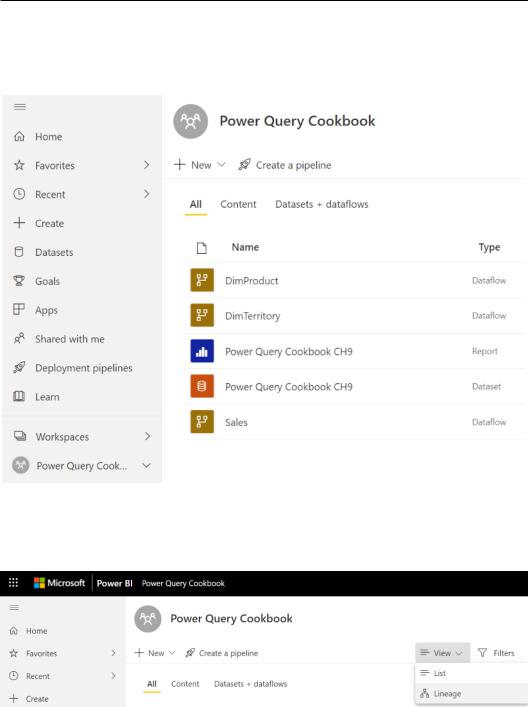
Centralizing ETL with dataflows 325
Now, again, open your browser and open the workspace where you have published these elements and follow the next steps:
1. Observe the elements displayed in the workspace:
Figure 9.32 – Workspace view
2.Click on View and then on Lineage to see the preceding elements displayed in the lineage view:
Figure 9.33 – Lineage view button
